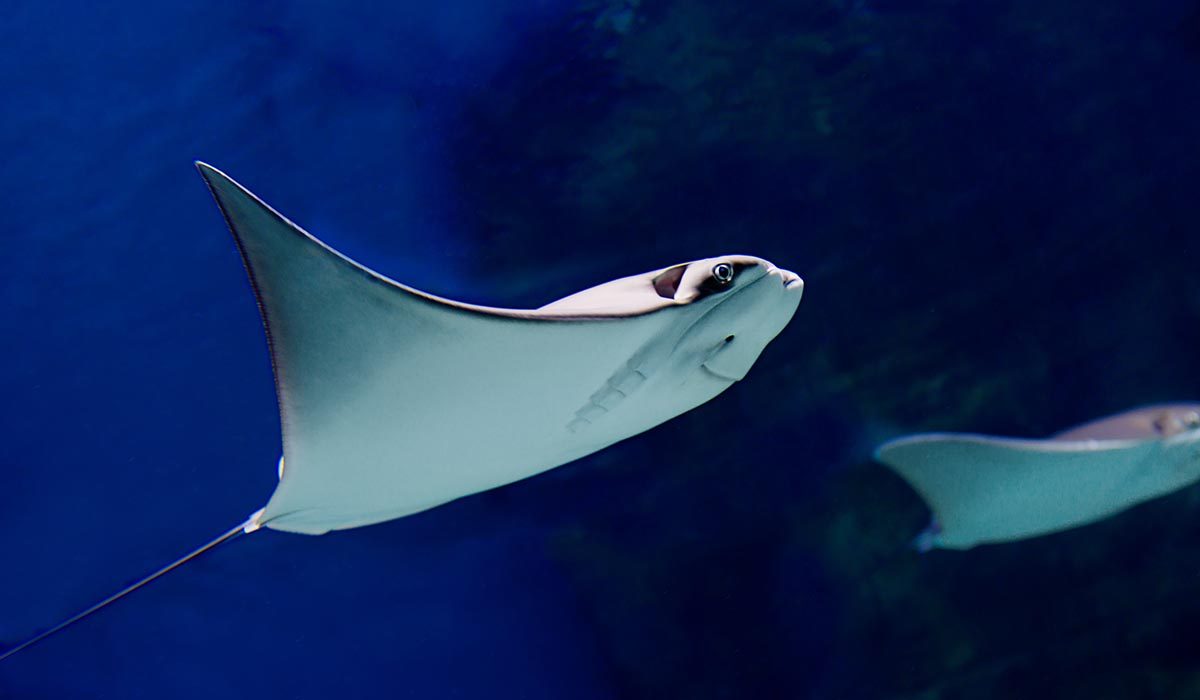“Wash thoroughly, use soap and keep it clean and dry.”
Bites account for the majority of marine life associated trauma. Fortunately, serious encounters are extremely rare. Traumatic injuries are usually the result of an animal’s defensive reaction to a perceived threat or misidentification of a diver’s body part as a food source. Most puncture wounds do not contain venom and are, therefore, a traumatic injury. Bleeding is the most common acute complication to trauma, while infections are the most common secondary complication. In this chapter, we will cover the more common traumatic injuries, how to prevent them and how to properly manage them.
In this chapter, you’ll learn about:
Skin Abrasions
An abrasion is a superficial scrape that occurs when the skin is rubbed or bumped against a rough object.
Epidemiology
Skin abrasions, minor skin cuts and scrapes are very common among recreational divers. Accidental contact with rocks, corals, wrecks and other hard surfaces in or around dive sites can cause injury. Divers with poor buoyancy control frequently report abrasions. In addition, divers who dive close to the bottom or through narrow passageways without the protection of full-length wetsuits often report minor abrasions on their lower extremities.
Risks to Divers
Skin abrasions expose your underlying tissues to microorganisms, significantly increasing the risk of infections. Bleeding can also be of concern, particularly when the injury occurs on highly perfused areas like your face, head, hands and fingers.
Prevention
To avoid skin abrasions, you must master buoyancy control and use mechanical protection like gloves and full-body wetsuits. Though thermal insulation may not be necessary in tropical dive destinations, protection from potential skin abrasions as well as from stinging microscopic life is always a good idea. It is important to note that in an attempt to protect underwater fauna, gloves might not be permitted at some dive destinations. Ask the local dive operator about its protocols before wearing gloves; it may help to explain your reasons for wanting to wear them.
First Aid
In case of minor skin abrasions, follow these basic first aid guidelines:
- Wash the area thoroughly with clean freshwater (sterile if available).
- Apply antiseptic solution (iodine-based antiseptic solutions may be contraindicated in patients with hyperthyroidism).
- Control bleeding by applying direct pressure with a sterile bandage.
- If bleeding has been controlled:
- Let the area dry out.
- Apply triple antibiotic ointment.
- Cover the area with a sterile bandage.
- Have the wound evaluated by a medical professional within 24 hours to assess risk of infections.
- If bleeding persists:
- Cover the wound with clean dressings and keep them in place.
- Continue to apply pressure.
- Seek an immediate medical evaluation.
- If bleeding has been controlled:
Treatment
For abrasions or amputations with significant bleeding, contact local emergency medical services immediately, apply bleeding control techniques and monitor the patient’s vital signs. Be prepared to manage shock.
Stingrays
Stingrays are shy, peaceful fish. They do not represent a threat to divers unless startled, stepped on or deliberately corralled and threatened. Most injuries occur in shallow waters when divers or swimmers are walking in areas where stingrays reside.
Biology and Identification
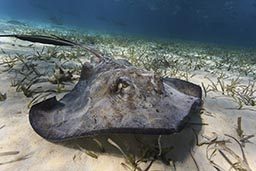
Rays are closely related to sharks: class Chondrichthyes, chondr- meaning cartilaginous and -ichthyes meaning fish. It’s important to note that not all rays have stingers. Stingrays are a specific group of rays classified in the suborder Myliobatoidei, which consists of eight families: deep water stingrays, sixgill stingrays, stingarees, round rays, butterfly rays, river stingrays, eagle rays and whiptail stingrays.
The approximate stingray wingspan varies across species from one foot to more than six feet (two meters). Some freshwater species can weigh up to 1,300 pounds (600 kilograms).
Distribution
There are species of stingrays in nearly all oceans. Some families consist of only freshwater species, which are typically found in tropical, subtropical and temperate river environments.
Mechanism of Injury
Stingrays are not aggressive by any means, and injuries are rarely fatal. The stingray’s defense mechanism consists of a serrated barb at the end of its tail with venom glands located at the base of the barb. The venom is a variable mixture of substances, none of which are specific to the animal; therefore, the creation of antivenom is not possible. Stingrays will strike when threatened or stepped on. The barb can easily tear wetsuits and penetrate skin, and may cause deep, painful lacerations.
Epidemiology
It is estimated that stingrays are responsible for approximately 1,500 accidents each year in the United States. Prevalence on other countries might be higher, particularly injuries associated with freshwater species, but epidemiological data is either elusive or inexistent.
Signs and Symptoms
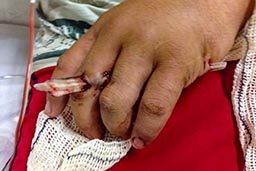
Stingrays can inflict mild to severe puncture wounds or lacerations. The initial symptom is pain, which can be significant and intensify over several hours. Both puncture wounds and lacerations can damage major blood vessels causing severe, potentially life-threatening bleeding. The barb usually breaks off and may require professional surgical care.
It is common for stingray wounds to become infected despite proper care. Notable possible infections include cellulitis, myositis, fasciitis and tetanus.
Prevention
- Avoid stepping in murky or low-visibility shallow waters where stingrays naturally inhabit.
- Stingrays often burrow in the sand, making them difficult to see even in tropical waters.
- If you are shore diving and you suspect there may be stingrays, carefully shuffle your feet while entering or exiting the water. This technique is known as the “stingray shuffle.” Stingrays are very sensitive animals, and the vibrations caused by this shuffling may scare them away.
First Aid
- Clean the wound thoroughly.
- Control bleeding if necessary.
- Do not delay professional medical evaluation. The risk for tetanus and other serious infections must be professionally minimized.
Sea Urchins
Sea urchins are typically small, rounded spiny creatures found on shallow rocky marine coastlines. The primary hazard associated with sea urchins is contact with their spines.
Biology and Identification
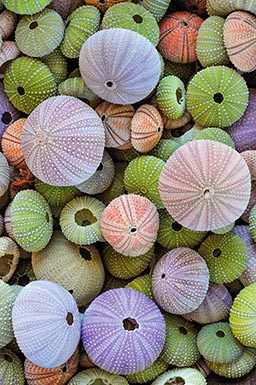
Sea urchins are echinoderms, a phylum of marine animals shared with starfish, sand dollars and sea cucumbers. Echinoderms are recognizable, because their pentaradial symmetry (they have five rays of symmetry), which is easily observed on a starfish. This symmetry corresponds with a water vascular system used for locomotion, transportation of nutrients and waste, and respiration. Sea urchins have tubular feet called pedicellariae, which enable movement. In one genus of sea urchin— the Flower Sea Urchin—some of the pedicellariae have evolved into toxic claws. In this species, the spines are short and harmless, but these toxic claws can inflict an envenomation.
Sea urchins feed on organic matter in the seabed. Their mouth is located on the base of their shell and their anus is on the top. The color of sea urchins varies depending on the species—shades of black, red, brown, green, yellow and pink are common.
Distribution
There are species of sea urchins in all oceans from tropical to arctic waters. Most human-sea urchin incidents occur
in tropical and subtropical waters.
Mechanism of Injury
Sea urchins are covered in spines, which can easily penetrate divers’ boots and wetsuits, puncture the skin and break off. These spines are made of calcium carbonate, the same substance that comprises eggshells. Sea urchin spines are usually hollow and can be fragile, particularly when it comes to extracting broken spines from the skin. Injuries usually happen when people step on them on while walking across shallow rocky bottoms or tide pools. Divers and snorkelers are often injured while swimming on the surface in shallow waters as well as when entering or exiting the water from shore dives.
Epidemiology
Although little epidemiological data is available, sea urchin puncture wounds are common among divers, particularly when in shallow waters, near rocky shores or in close proximity to wrecks and other hard surfaces. The DAN Medical Information team receives at least one call a week regarding sea urchin injuries, typically from divers and snorkelers swimming in very shallow waters near rocky shores.
Signs and Symptoms
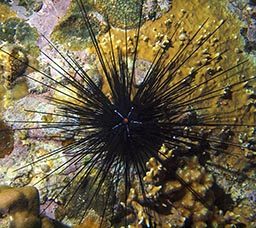
Injuries are typically in the form of puncture wounds, often multiple and localized. Skin scrapes and lacerations are also possible. Puncture wounds are generally painful and associated with redness and swelling. Pain ranges from mild to severe depending on several factors, including the species, the body area of the wound, joint or muscular layers compromised, number of punctures, depth of puncture, and the individual’s threshold for pain. Multiple puncture wounds may cause limb weakness or paralysis, particularly with the long-spined species of the genus Diadema. On very rare occasions, immediate life-threatening complications may occur.
Prevention
- Be observant while entering or exiting the water from shore dives, particularly when the bottom is rocky.
- If swimming, snorkeling or diving in shallow waters, near rocky shores or in close proximity to wrecks and other hard surfaces, maintain a prudent distance and buoyancy control.
- Avoid handling these animals.
First Aid
There is no universally accepted treatment for sea urchin puncture wounds. Both first aid and definitive care is symptomatic.
- Apply heat. Immerse the affected area in hot water (upper limit of 113°F/45°C) for 30 to 90 minutes. If you are assisting a sting victim, try the water on yourself first to assess tolerable heat levels. Do not rely on the victim’s assessment, as pain may impair his ability to evaluate tolerable heat levels. If you cannot measure water temperature, a good rule of thumb is to use the hottest water you can tolerate without scalding. Note that different body areas have different tolerance to heat, so test the water on the same area where the diver was injured. Repeat if necessary.
NOTE: Very few species of sea urchins contain venom. If present, hot water immersion may also help denature any superficial toxins. - Remove any superficial spines. Tweezers can be used for this purpose; however, sea urchin spines are hollow and can be very fragile when grabbed from the sides. Your bare fingers are a softer alternative to hard tweezers.
NOTE: Do not attempt to remove spines embedded deeper in the skin; let those be handled by medical professionals. Deeply embedded spines may break down into smaller pieces, complicating the removal process. - Wash the area thoroughly, but avoid forceful rubbing and scrubbing if you suspect there may still be spines embedded in the skin.
- Apply antiseptic solutions or over-the-counter antibiotic ointments if available.
- Do not close the wound with tape or glue; this might increase the risk of infection.
NOTE: Deep puncture wounds are the perfect environment to culture an infection, particularly tetanus. - Regardless of any first aid provided, always seek a professional medical evaluation.
Treatment
Contrary to popular belief, very few species of sea urchins are actually toxic. Pain and swelling is often the result of
the body’s reaction to myriad different antigens present on the surface of the spines.
Spines are usually covered with strong pigments, so individual puncture wounds are often clearly visible and may
cause suspicion that each puncture contains a fragment of a spine. Though this is possible, it may not necessarily be
the case. It is easier to assess each individual puncture once the acute inflammatory process has started to recess.
The decision of whether or not surgical removal of retained spines is necessary is usually based on joint or muscular
layer involvement, and whether there is pain with movement or signs of infection. Spines will usually encapsulate in a
short time, but they may not always dissolve. A reactive granuloma is a common reaction to remaining small foreign
bodies. Radiological localization, fluoroscopy or an ultrasound might be useful to avoid a blind surgical extraction
that may cause further spine fracture.
The use of anti-inflammatories and physical therapy is often key for managing these injuries, particularly when they
involve small joints as a prolonged inflammatory process may result in fibrosis, which may limit range of motion.
If signs of infection are present, the doctor may prescribe antibiotics and a tetanus booster.
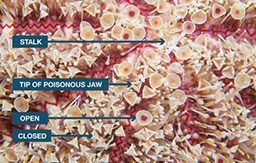
Flower Sea Urchin
The Flower Sea Urchin (Toxopneustes spp.) is the most toxic of all sea urchins. Its short spines are harmless, but its pedicellariae, which look like small flowers, are tiny claws (Toxopnueustes, meaning toxic foot). These claws contain a toxin that can cause severe pain similar to that of a jellyfish sting, faint giddiness, difficulty breathing, slurred speech, generalized weakness, and numbness of the lips, tongue and eyelids.
